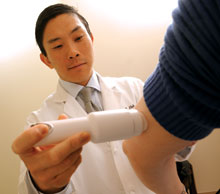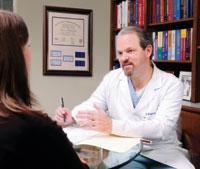Incubating Breakthroughs in Cervical Cancer and Infertility
By Troy Goodman
 |
Warner Huh uses the “gene gun” to administer a DNA-based HPV vaccine. |
UAB’s Women & Infants Center was designed to welcome new lives into the world—and breathe life into new ideas that could change the world. Like vaccines that could help reduce anxiety as well as prevent disease. And treatments that can preserve a patient’s chances to start a family.
Before moving into the new facility, UAB’s Department of Obstetrics and Gynecology already was a key component of four federally funded national research networks. Now all of them—along with scientists from each of the department’s divisions—converge in the building, creating a powerhouse of discovery.
Last year, UAB gynecologic oncologists became part of a fifth network when the National Cancer Institute awarded an $11.5-million Specialized Program of Research Excellence (SPORE) grant in cervical cancer to the UAB Comprehensive Cancer Center, Johns Hopkins University, and the University of Colorado at Boulder. The SPORE focuses on developing next-generation human papillomavirus (HPV) vaccines to prevent cervical cancer and testing new therapeutic agents that show promise in preventing, slowing, or treating the disease.
Health officials recommend routine vaccination for girls (ages 11-12) and catch-up shots for females (ages 13-26) using two approved vaccines, Gardasil and Cervarix. The vaccines help generate antibodies capable of preventing infection by two of HPV’s most worrisome strains, HPV 16 and HPV 18, which cause 70 percent or more of all cervical cancers. But these existing vaccines have limitations. Namely, they protect against only a small number of HPV strains, and they are cost-prohibitive for cancer-prevention programs in developing countries and even rural Alabama.
“We can’t sit back, rest on our laurels, and say we have vaccines that work,” says Warner Huh, M.D., an associate professor of obstetrics and gynecology and SPORE co-lead investigator. “The SPORE is about taking those advances forward and looking for affordable, effective, and durable agents that can help eliminate the burden of disease worldwide.”
Reducing Cancer, Easing Fears
 |
G. Wright Bates encourages women to discuss fertility preservation options with their physicians before receiving treatment for diseases such as cancer. |
One SPORE project that holds promise is called the L2 prophylactic vaccine, which targets an HPV protein that helps generate antibodies capable of preventing infection by a diverse number of HPV strains. Huh says having an inexpensive vaccine that covers all cancer-causing types would be a windfall in the global cancer fight.
A broad-spectrum vaccine could reduce or eliminate the need for Pap testing, saving health-care dollars and reducing patient stress. “I can see us going beyond reducing the morbidity and mortality related to invasive cervical cancer, which in itself would be a huge victory,” Huh says. “We have a clear chance to reduce the enormous financial impact and terrible anxiety associated with the diagnosis and treatment of women with precancerous lesions of the cervix.”
Another initiative is testing a “gene gun,” a needle-free method of administering a DNA-based HPV vaccine. In this case, the vaccine is delivered to the epidermal layer, where the immune response may be greater than in the muscle. Ronald Alvarez, M.D., director of the UAB Division of Gynecologic Oncology, is co-principal investigator for this phase I trial.
Other SPORE research is investigating HPV treatment options. “We’re looking at unique agents—therapeutic vaccines or immunotherapeutics—that hopefully will be used to treat women with cancer and also precancerous diseases like cervical dysplasia,” or the appearance of abnormal cells, Huh says.
Protecting Fertility
Specialists also are exploring new territory in preserving and restoring fertility, particularly for women facing medical treatments such as chemotherapy or radiation that may impact childbearing. UAB studies and offers the latest solutions through its Reproductive Endocrinology and Infertility Services Clinic, says G. Wright Bates, M.D., associate professor of obstetrics and gynecology and the clinic’s director.
Discovery NetworksUAB’s ob/gyn department plays key roles in major research networks:
|
Options for women include in vitro fertilization (IVF) and embryo freezing, IVF and egg freezing, and ovarian tissue freezing and reimplantation. “As far as we know, frozen eggs, embryos, and ovarian tissue are good indefinitely,” Bates says. After their medical treatments, women within a specified age bracket can expect a high degree of success at achieving pregnancy using these methods, he adds.
With IVF and embryo freezing, women take fertility medications prior to the retrieval of eggs, which happens before medical treatment begins. The eggs are fertilized through IVF in the laboratory, and the embryos are frozen. For IVF and egg freezing, the eggs are harvested and frozen without fertilization so that they can be used later for IVF. Because of the risks and difficulties surrounding pregnancy for women in their 40s or later, UAB does not routinely offer IVF for women who have reached age 43, Bates says.
Ovarian tissue freezing requires tissue retrieval before medical treatment. The tissue is then frozen and stored for reimplantation in the ovary after treatment is complete, restoring normal hormone production. Patients choosing this method do not need the fertility treatments required for IVF.
Bates adds that each patient’s options and ability to have children will depend on her particular course of medical treatment and other factors, but he encourages women to discuss reproductive issues with their doctors. “If there’s a desire to start or continue a family in the future, now is the time to talk about it,” he says.
